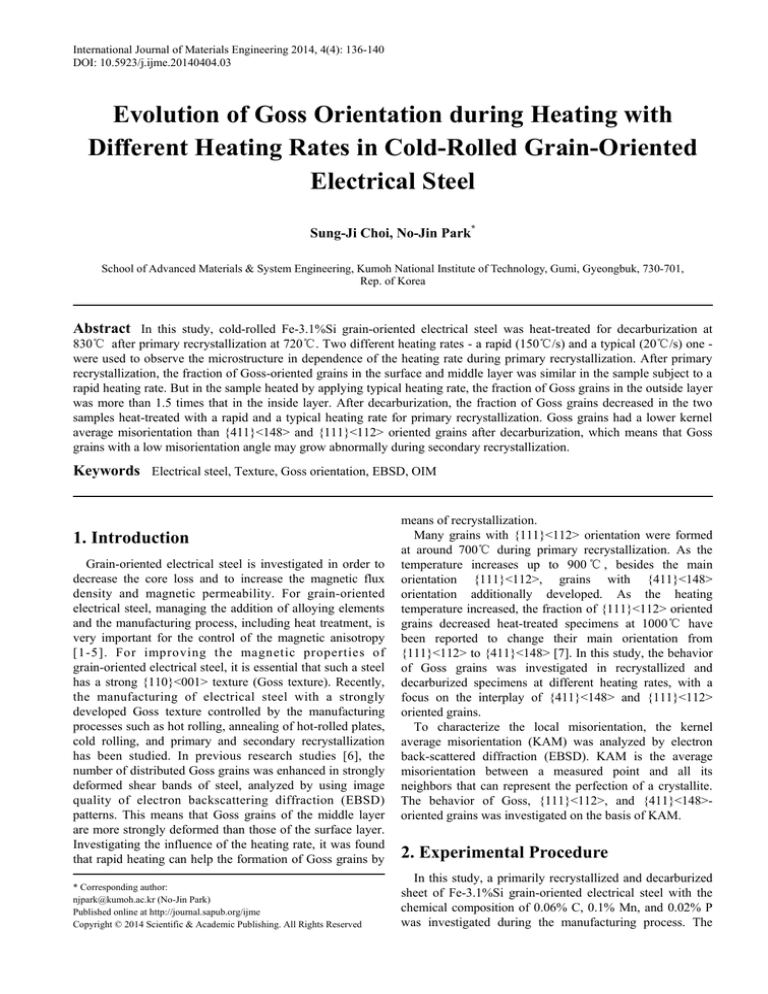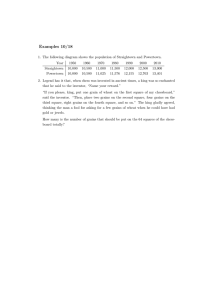
International Journal of Materials Engineering 2014, 4(4): 136-140
DOI: 10.5923/j.ijme.20140404.03
Evolution of Goss Orientation during Heating with
Different Heating Rates in Cold-Rolled Grain-Oriented
Electrical Steel
Sung-Ji Choi, No-Jin Park*
School of Advanced Materials & System Engineering, Kumoh National Institute of Technology, Gumi, Gyeongbuk, 730-701,
Rep. of Korea
Abstract In this study, cold-rolled Fe-3.1%Si grain-oriented electrical steel was heat-treated for decarburization at
830℃ after primary recrystallization at 720℃. Two different heating rates - a rapid (150℃/s) and a typical (20℃/s) one were used to observe the microstructure in dependence of the heating rate during primary recrystallization. After primary
recrystallization, the fraction of Goss-oriented grains in the surface and middle layer was similar in the sample subject to a
rapid heating rate. But in the sample heated by applying typical heating rate, the fraction of Goss grains in the outside layer
was more than 1.5 times that in the inside layer. After decarburization, the fraction of Goss grains decreased in the two
samples heat-treated with a rapid and a typical heating rate for primary recrystallization. Goss grains had a lower kernel
average misorientation than {411}<148> and {111}<112> oriented grains after decarburization, which means that Goss
grains with a low misorientation angle may grow abnormally during secondary recrystallization.
Keywords Electrical steel, Texture, Goss orientation, EBSD, OIM
1. Introduction
Grain-oriented electrical steel is investigated in order to
decrease the core loss and to increase the magnetic flux
density and magnetic permeability. For grain-oriented
electrical steel, managing the addition of alloying elements
and the manufacturing process, including heat treatment, is
very important for the control of the magnetic anisotropy
[1-5]. For improving the magnetic properties of
grain-oriented electrical steel, it is essential that such a steel
has a strong {110}<001> texture (Goss texture). Recently,
the manufacturing of electrical steel with a strongly
developed Goss texture controlled by the manufacturing
processes such as hot rolling, annealing of hot-rolled plates,
cold rolling, and primary and secondary recrystallization
has been studied. In previous research studies [6], the
number of distributed Goss grains was enhanced in strongly
deformed shear bands of steel, analyzed by using image
quality of electron backscattering diffraction (EBSD)
patterns. This means that Goss grains of the middle layer
are more strongly deformed than those of the surface layer.
Investigating the influence of the heating rate, it was found
that rapid heating can help the formation of Goss grains by
* Corresponding author:
njpark@kumoh.ac.kr (No-Jin Park)
Published online at http://journal.sapub.org/ijme
Copyright © 2014 Scientific & Academic Publishing. All Rights Reserved
means of recrystallization.
Many grains with {111}<112> orientation were formed
at around 700℃ during primary recrystallization. As the
temperature increases up to 900 ℃ , besides the main
orientation {111}<112>, grains with {411}<148>
orientation additionally developed. As the heating
temperature increased, the fraction of {111}<112> oriented
grains decreased heat-treated specimens at 1000℃ have
been reported to change their main orientation from
{111}<112> to {411}<148> [7]. In this study, the behavior
of Goss grains was investigated in recrystallized and
decarburized specimens at different heating rates, with a
focus on the interplay of {411}<148> and {111}<112>
oriented grains.
To characterize the local misorientation, the kernel
average misorientation (KAM) was analyzed by electron
back-scattered diffraction (EBSD). KAM is the average
misorientation between a measured point and all its
neighbors that can represent the perfection of a crystallite.
The behavior of Goss, {111}<112>, and {411}<148>oriented grains was investigated on the basis of KAM.
2. Experimental Procedure
In this study, a primarily recrystallized and decarburized
sheet of Fe-3.1%Si grain-oriented electrical steel with the
chemical composition of 0.06% C, 0.1% Mn, and 0.02% P
was investigated during the manufacturing process. The
International Journal of Materials Engineering 2014, 4(4): 136-140
initial sheet had a thickness of 2.0 mm, and was cold rolled
to 0.3 mm in thickness. For the primary recrystallization,
continuous heating was conducted until 720 ℃ with
different heating rates, either rapid heating with a rate of
150℃/s or conventional heating with a typical rate of
20℃/s, which are selected to base on previous research [6].
The recrystallized sheet was decarburized at 830℃. The
observed microstructures were in accordance with the
heating rate during primary recrystallization and
decarburization.
EBSD and orientation image mapping (OIM) were used
for identifying Goss, {411}<148>, and {111}<112>oriented grains and the area fraction, the grain size, and the
distribution of Goss-oriented grains was observed in
dependence of the heating rate. OIM was carried out in the
transverse direction (TD)-plane of the sheet using field
emission scanning electron microscopy (FE-SEM, Hitachi
S-4300 SE). In case of the primarily recrystallized and
decarburized steel sheet, the step size was 0.5 ㎛ and 3 ㎛,
corresponding to a total measured area of 500 µm × 250 µm
and 4100 µm × 280 µm respectively. Goss, {411}<148>, and
{111}<112> orientations are represented by red, blue, and
green in OIM, respectively.
137
was different. The average area fraction of Goss grains was
1.85%, but the Goss fraction of the outside layer was 1.5
times larger than of in the inside layer. The average grain
size of Goss oriented grains was 2.88 µm applying a typical
heating rate and 2.51 µm for rapid heating. Hence, in case
of rapid heating, the Goss fraction was larger and the grain
size was smaller than for a typical heating rate. Figure 2(b)
shows the KAM of all grains including Goss grains. KAM
of the sample to typical heating rate was lower than in case
of rapid heating. Therefore, specimens heat-treated with a
typical heating rate showed almost perfect crystallites and
formed bigger grains than rapidly heated samples. In other
words, a rapid heating rate results in higher local stress
compared to a typical heating rate.
3. Results and Discussion
Figure 2. (a) Area fraction and (b) KAM distribution of Goss oriented
grains after recrystallization, heated with a rapid and a typical rate
Figure 1. OIM of the recrystallized steel sheet obtained by EBSD with a
step size of 0.5 µm in thickness, heated with (a) a rapid and (b) a typical
heating rate, ND (normal direction)-RD (rolling direction) section
Figure 1 shows the resulting OIM of a part of the primary
crystallized specimen with a step size of 0.5 µm. The
tolerance angle was ±15° for a given orientation. Figure 2
shows the KAM distribution of Goss grains. The KAM was
calculated considering with next-nearest neighbors. In case
of rapid heating, the area fraction of Goss grains was 2.3%
and the fraction of the surface and the middle layer was
similar. However, in case of a typical heating rate, the result
Figure 3 shows a part of the OIM of the decarburized
specimen, measured with a step size of 3 µm, corresponding
to a measured area of 4100 µm × 280 µm. Figure 4 shows
the fraction of Goss grains and the distribution of KAM. In
case of rapid heating, the average fraction of Goss grains is
1.95% and the grain size is 16.37 µm. In case of a typical
heating rate, the average fraction of Goss grains is 1.3% with
a grain size is 14.55 µm. After decarburization, the area
fraction of Goss grains was decreased as compared with the
sample after primary recrystallization. Comparing Figures
2(b) and 4(b), Goss-oriented grains with a low misorientation
angle grew during decarburization at 830℃. This result
could indicate that Goss grains grew with a KAM angle of
138
Sung-Ji Choi et al.: Evolution of Goss Orientation during Heating with Different Heating
Rates in Cold-Rolled Grain-Oriented Electrical Steel
less than 0.6° while those with a KAM angle of more than
0.6° disappeared during the decarburization process.
Moreover, the sample heat-treated with a rapid heating rate
has a smaller KAM angle after decarburization, simplying
that rapid heating during recrystallization can support the
generation of perfect Goss grains.
Figure 3. Orientation imaging mapping of decarburized steel sheet
obtained by EBSD with a step size of 3 µm in thickness, heated with (a)
rapid and (b) typical heating rate, ND-RD section
size increases, the driving force for grain growth decreases,
which means the start temperature for secondary
recrystallization increases. After secondary recrystallization
is completed, the steel will have excellent magnetic
properties [9].
The fraction of Goss grains decreased less in case of
rapid heating than for a typical heating rate. The perfection
of crystallites is reflected by a low KAM. Therefore, we
expect that Goss grains disappear to a lesser extent
compared with differently oriented grains during grain
growth. These results can affect the abnormal grain growth
during secondary recrystallization.
Figure 5 shows the area fractions of {411}<148> and
{111}<112> oriented grains which can affect the growth of
Goss grains. For the two different heating rates, after
decarburization the {411}<148> orientation fraction is
increased by about 1.5 times and the {111}<112>
orientation fraction is decreased by about 0.8 times. The
fractions of {411}<148> and {111}<112>-oriented grains,
neighbored by Goss grains, are shown in Figure 6. This
figure suggests a correlation between {411}<148>,
{111}<112>, and Goss orientation. In case of rapid heating,
the fraction of {411}<148>-oriented grains decreased by
about 0.6 times after decarburization, but {111}<112>
fraction is not changed. In case of a typical heating rate, the
{411}<148> fraction decreased by about 0.7 times after
decarburization, but, again, the fraction of the {111}<112>
orientation is not changed.
Figure 5. Area fraction of {411}<148> and {111}<112> oriented grains
in the sheet sample after recrystallization with a rapid and a typical heating
rate and after decarburization
Figure 4. (a) Area fraction and (b) KAM distribution of Goss oriented
grains after decarburization, heated with a rapid and a typical rate
The grain size after decarburization at 830℃ is grown by
about 6.5 times in the sample subject to a rapid heating rate
and about 5.1 times in case of a typical heating rate, which
indicating that the heating rate during recrystallization
affects the grain growth. The grain size as resulting frome
primary recrystallization can change the onset temperature
of secondary recrystallization and influences the magnetic
properties after secondary recrystallization [8]. If the grain
After decarburization, the fraction of the Goss orientation
is decreased, whereas the fraction of the {411}<148>
orientation is increased. In addition, the number of grains of
{411}<148> orientation neighbored by Goss grains is
decreased. Therefore, we expect that the growth of
{411}<148> grains encroached Goss grains. The fraction of
{111}<112> grains is similar after primary recrystallization
and decarburization. This result shows that {111}<112>
grains have a weaker relationship to Goss grains in case the
grain growth takes place at 830℃. In addition, the heating
rate affected the neighboring distribution of Goss grains to a
International Journal of Materials Engineering 2014, 4(4): 136-140
lesser extent.
Figure 6. Fraction of {411}<148> and {111}<112> oriented grains
which are neighbored with Goss grains after recrystallization with a rapid
and a typical heating rate and after decarburization
139
than for a typical heating rate. The driving force for grain
growth can be the difference of internal energy between
strained and unstrained grains. The grains form as small
grain and grow until they completely consume the parent
grains, processes that involve short-range diffusion [10].
Considered from the perspective of KAM, Goss grains with
a low KAM can grow easily because they have a low
internal energy. The KAM of Goss grains is lower than that
of {411}<148> and {111}<112>-oriented grains. It is
expected that these {411}<148> and {111}<112> oriented
grains can be consumed for the abnormal growth of Goss
grains during secondary recrystallization. This trend
strongly appears in case of rapid heating during
recrystallization and, therefore, rapid heating is expected to
be beneficial for the growth of Goss grains.
4. Conclusions
1. After primary recrystallization, the KAM of the sample
heat-treated with a typical heating rate was lower than in case
of rapid heating. Therefore, specimens heated by a typical
rate showed almost perfect crystallites that were bigger in
size than in case of a rapid heating rate. In other words, a
rapid heating rate results in higher local stress compared to a
typical heating rate.
2. After decarburization, the area fraction of Goss grains
was reduced compared with the sample after primary
recrystallization. Moreover, the sample heat-treated with a
rapid heating rate has a smaller KAM angle after
decarburization, implying that rapid heating during
recrystallization can support the generation of perfect Goss
grains.
3. The KAM of Goss grains is lower than that of
{411}<148> and {111}<112> oriented grains. It is expected
that these {411}<148> and {111}<112> oriented grains can
be consumed for the abnormal growth of Goss grains during
secondary recrystallization.
ACKNOWLEDGEMENTS
This paper was supported by Research Fund, Kumoh
National Institute of Technology.
Figure 7. KAM distribution of Goss, {411}<148>, and {111}<112>
oriented grains after decarburization, heat-treated with (a) a rapid and (b) a
typical rate
Figure 7(a) and (b) shows the KAM distribution of Goss,
{411}<148>, and {111}<112> oriented grains after
decarburization at 830℃. In the rapidly heated sample,
77.4% of the Goss oriented grains have a KAM angle of
less than 0.6°, and in the sample heat-treated with a typical
heating rate, 70.7% of the Goss oriented grains have such a
low KAM angle of less than 0.6°. In other words, the KAM
of Goss grains was significantly smaller; accordingly, the
crystallites are more perfect in case of a rapid heating rate
REFERENCES
[1]
Yoshitomi Y., Iwayama K., Kuroki K., et al., 1993,
Influence of annealing before 1st cold rolling on secondary
recrystallization of Fe-3%Si alloy. The Japan Institute of
Metals and Materials 57(6), 612-620.
[2]
Matsuo M., Sakai T., Tanino M., et al., 1981, Effects of cold
rolling reduction and the AIN precipitate morphology on
primary recrystallization texture formation in high
permeability grain oriented silicon steel. Proceedings of the
6th International Conference on Textures of Materials, The
140
Sung-Ji Choi et al.: Evolution of Goss Orientation during Heating with Different Heating
Rates in Cold-Rolled Grain-Oriented Electrical Steel
heating rate for primary recrystallization in grain-oriented
electrical steel. The Iron and Steel Institute of Japan 53(1),
125–130.
Iron and Steel Institute of Japan 2, 918-927.
[3]
Iwayama K., and Haratani K., 1980, The dissolution and
precipitation behavior of AIN and MnS in grain-oriented 3%
silicon-steel with high permeability. Journal of Magnetism
and Magnetic Materials 19(1-3), 15-17.
[4]
Datta A., 1976, An investigation of the differences in
deformation and recrystallization behavior of conventional
and high permeability silicon steel with special reference to
the formation of (110)[001] nuclei. IEEE Transactions on
Magnetics 12(6), 867-869.
[5]
Xia Z., Kang Y., and Wang Q., 2008, Developments in the
production of grain-oriented electrical steel. Journal of
Magnetism and Magnetic Materials 320(23), 3229-3323.
[6]
Park N. J., Joo H. D., and Park J. T., 2013, Evolution of
Goss orientation during thermal heating with different
[7]
Han K. S., Kim J. K., Park J. T., et al, 2007, Evolution of the
texture on primary recrystallization and grain growth in
Fe-3%Si Steels. Materials Science Forum 12(1), 747-750.
[8]
Fujii N., Ushigami Y., and Kubota T., 1996, Influence of
primary
recrystallized
structure
on
secondary
recrystallization temperature in Fe-3%Si alloy, CAMP-ISIJ
9(3), 444.
[9]
Han K. S., Choi G. S., and Woo J. S., 2001, Effects of
microstructure before high temperature annealing on
secondary recrystallization in conventional grain-oriented
electrical steels, Journal of the Korean Institute of Metals
and Materials 39(4), 466-453.



